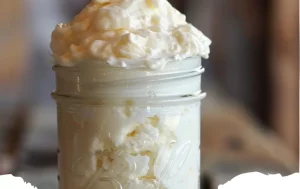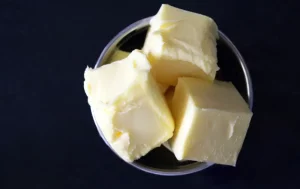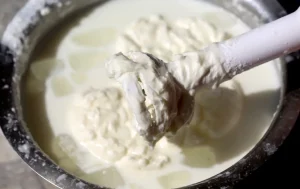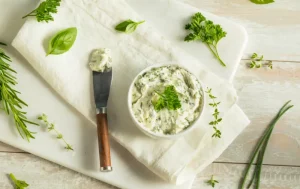Making homemade butter is a simple, satisfying process that transforms fresh cream into rich, flavorful butter with just a few steps. This age-old technique not only allows for customization of flavors and salt content but also connects us to the traditional practices of our ancestors. Homemade butter boasts a freshness and quality that store-bought versions often cannot match, making it a delightful addition to any cook’s repertoire.
Print
Homemade Butter
- Total Time: 15 minutes
- Yield: Approximately 1 cup of butter
- Diet: Vegetarian
Description
Homemade butter is a creamy, flavorful alternative to store-bought varieties, made by churning cream until it separates into butter and buttermilk. This simple process allows for a customizable taste and the satisfaction of creating a staple kitchen ingredient from scratch.
Ingredients
▢1 cup heavy cream 38% fat content
▢cold water
Instructions
Mixer Instructions
Pour cream into the bowl of a stand mixer using the whisk attachment, or use a mixing bowl and hand mixer. Begin beating the cream on a low speed, and gradually increase the speed as the mixture thickens.
After several minutes, whipped cream will form. Continue mixing. The whipped cream will start to yellow. After several minutes more the fat solids will separate from the liquids and you’ll see clumps of butter fat quickly form, leaving the sloshing liquid buttermilk in the bottom of the bowl.
Mason Jar Instructions
Pour heavy cream into the mason jar, filling it half-way full. Do not overfill past the half-way mark. Screw the lid on tightly so there are no leaks.
Shake mason jar for approximately 5-7 minutes. After a few minutes, whipped cream will form. Keep shaking until you hear that a lump has formed inside, and shake an additional 30-60 seconds after that. You should clearly see that the fat solids have separated from the liquids. The amount of time it takes will depend on how vigorously you are able to shake the jar.
Rinsing, Flavoring, and Storing
Strain the fat solids from the buttermilk using a fine mesh strainer or cheesecloth. You can reserve the buttermilk and save it for later use in recipes.
Pour cold water over the butter. Discard water and repeat rinsing 2 times more. Shape into a ball or any other shape (you can purchase butter molds for interesting designs).
At this point you have butter. You can add in things like salt, honey, and herbs to create flavored butters, or serve in its pure form as is.
Notes
- The quality of the cream significantly affects the taste and texture of the butter. For the best results, use fresh, high-quality heavy cream.
- You can add herbs, garlic, honey, or other flavorings to create various butter flavors.
- Gluten-Free, Keto (if unsalted), Vegetarian.
- Prep Time: 5 minutes
- Cook Time: 10 minutes
- Category: Basic Ingredient
- Method: Churning
- Cuisine: Universal
Nutrition
- Calories: 102
- Sugar: 0.01g
- Sodium: 2mg (varies with added salt)
- Fat: 11.52g
- Saturated Fat: 7.29g
- Carbohydrates: 0.01g
- Fiber: 0g
- Protein: 0.12g
- Cholesterol: 30.5mg
FAQs
Can I make butter without a mixer or food processor?
Yes, you can make butter using a jar with a tight-fitting lid. Fill the jar halfway with heavy cream and shake vigorously until the butter solids separate from the buttermilk.
How long does homemade butter last?
Properly stored in the refrigerator, homemade butter can last for up to three weeks. In the freezer, it can last for several months.
Is homemade butter healthier than store-bought?
Homemade butter can be healthier than store-bought versions because it lacks preservatives and additives. Using cream from grass-fed cows can also increase the nutritional value, offering higher levels of omega-3 fatty acids and vitamins.
Can I use low-fat cream to make butter?
Butter is made from the fat in cream, so low-fat cream won’t produce the same results. For best outcomes, use heavy cream with a high fat content.
What can I do with the leftover buttermilk?
The buttermilk from butter making is excellent in baked goods like pancakes, biscuits, or bread. It can also be used in marinades or salad dressings for added flavor.
The Basics of Butter Making
Butter is essentially the fat that separates from the liquid (buttermilk) when cream is agitated or churned. This process, known as churning, can be done with a variety of tools, from modern electric mixers to traditional hand churns or even a simple jar with a tight-fitting lid. The key ingredient is heavy cream, preferably from grass-fed cows for the best flavor and nutrient profile.
Step-by-Step Guide to Making Butter
- Start with Heavy Cream: Pour heavy cream into your chosen churning device. If using a mixer or food processor, fill it no more than halfway to allow space for the cream to expand.
- Churn the Cream: Begin churning. First, the cream will turn into whipped cream. Continue past this stage until the fats separate and solidify, forming butter and buttermilk.
- Separate the butter from the buttermilk. Once the butter has formed, pour off the buttermilk (save it for baking!). You’ll be left with solid butter.
- Rinse the Butter: Place the butter in a bowl and rinse it under cold water, kneading it to remove any remaining buttermilk. This helps improve the butter’s shelf life.
- Flavor and Store: At this point, you can add salt or other flavorings as desired. Shape the butter as you like, then store it in the refrigerator or freezer.
Customizing Your Butter
One of the joys of homemade butter is the ability to customize it. Salted or unsalted, herbs, garlic, honey, or even edible flowers can be incorporated to create unique flavor profiles. Experimenting with these additions can turn a simple loaf of bread or a cooked dish into something extraordinary.
Tips for Perfect Homemade Butter
- Use the freshest cream you can find for the best-tasting butter.
- Temperature matters: warmer cream (about 60°F to 65°F) will churn into butter more quickly than cold cream straight from the fridge.
- Rinse the butter thoroughly to ensure all buttermilk is expelled, which will enhance its longevity.
The Benefits of Homemade Butter
Creating your own butter is not just about the end product; it’s an experience that offers a sense of accomplishment and connection to the food we consume. Homemade butter tends to be richer in flavor and offers a more authentic taste. Additionally, making butter at home allows for control over the ingredients, ensuring a natural, preservative-free product.
Making homemade butter is a rewarding endeavor that results in a superior product perfect for spreading on bread, cooking, and baking. Its rich flavor and customizable nature make it a worthy addition to any kitchen, promising an enhanced culinary experience with every use.
Exploring the Nutritional Value of Homemade Butter
Homemade butter is not only about indulging in its rich flavor but also appreciating its nutritional content. Packed with fat-soluble vitamins such as A, D, E, and K2, especially when made from the cream of grass-fed cows, homemade butter can be a valuable part of a balanced diet. It also contains beneficial fatty acids and trace minerals, highlighting the importance of quality ingredients for a healthier option.
Serving Suggestions for Homemade Butter
The versatility of homemade butter extends to a myriad of culinary applications. Spread it on freshly baked bread or rolls for a simple yet sublime experience. It can elevate the taste of steamed vegetables, enhance sauces, and make for an exquisite base for compound butters. Incorporating herbs, spices, or sweeteners can transform it into a specialty butter suitable for various dishes, from savory meals to desserts.
The Environmental Impact of Making Butter at Home
Making butter at home also has an environmental aspect, reducing the carbon footprint associated with commercial butter production and packaging. By sourcing cream from local dairies, you support sustainable farming practices and reduce transportation emissions. Additionally, homemade butter avoids the plastic packaging of commercial products, contributing to less waste.
Butter Making as a Cultural and Educational Activity
Engaging in butter making can be a cultural exploration and educational activity, especially for younger generations. It offers a hands-on experience to learn about food origins, chemical processes, and the importance of traditional food practices. Making butter can be a fun family activity that provides insight into how everyday ingredients undergo transformation, fostering an appreciation for homemade foods.
Advancements in Home Butter Making Techniques
While the basic technique of making butter has remained consistent, modern kitchen tools have streamlined the process. Electric mixers, food processors, and even specialized butter churns available for home use have made the task quicker and more efficient. These advancements encourage experimentation with flavors and techniques, making butter more accessible to a wider audience.
Preserving and Storing Homemade Butter
Proper preservation and storage are crucial for extending the shelf life of homemade butter. After rinsing and shaping, butter can be wrapped in parchment paper or stored in an airtight container. Refrigeration keeps butter fresh for several weeks, while freezing can extend its life for months. This ensures that the effort put into making butter translates into long-term enjoyment.
Homemade butter, with its simple creation process and profound culinary and nutritional benefits, stands as a testament to the beauty of artisan food preparation. It not only brings unparalleled taste and quality to meals but also offers a way to connect with food’s natural origins, promoting a sustainable and mindful approach to consumption.
Innovating with Flavored Butter Varieties
Innovation doesn’t stop at basic homemade butter; it’s just the beginning. Culinary enthusiasts venture into creating an array of flavored butters, incorporating ingredients such as truffles, roasted garlic, or berries, to elevate everyday meals into gourmet experiences. These flavored butters can be tailored to complement specific dishes, from steaks and seafood to pancakes and pastries, showcasing the versatility and creativity that homemade butter invites.
The Social Aspect of Butter Making
Making butter at home can also foster social connections, whether through butter-making workshops, community events, or simply sharing the fruits of your labor with friends and family. It encourages a communal spirit where knowledge, techniques, and flavors are shared and celebrated. This aspect turns the process into a shared culinary adventure, strengthening bonds and creating lasting memories.
Health Consciousness and Homemade Butter
As health consciousness rises, so does the appreciation for homemade butter’s natural composition. Unlike commercial alternatives, which may contain additives and preservatives, homemade butter consists of cream and, optionally, salt. This simplicity appeals to those striving for a clean diet, allowing them to enjoy butter’s richness without concern for unnecessary ingredients.
Economic Benefits of DIY Butter Making
While the primary motivation for making butter at home is often for its superior taste and health benefits, there’s also an economic advantage. Purchasing cream in bulk and transforming it into butter can be cost-effective, especially when compared to the premium prices of artisan butters sold in specialty stores. This economic efficiency makes homemade butter an attractive option for those looking to enhance their culinary experiences without overspending.
The Future of Home Butter Making
Looking ahead, the trend of making butter at home is set to grow, driven by a desire for authenticity, quality, and the joy of crafting something with one’s own hands. As more people discover the satisfaction and delicious results of homemade butter, we may see further innovation in techniques, flavors, and uses, ensuring that this traditional skill remains relevant and cherished in modern kitchens.
Homemade butter stands as a symbol of culinary simplicity and richness, blending tradition with innovation. It’s a journey back to the basics of food preparation, offering a deeper understanding and appreciation for one of the kitchen’s most fundamental ingredients. Whether enjoyed on fresh bread, used in cooking, or given as a thoughtful homemade gift, butter made at home carries with it the imprint of care, quality, and creativity.
Conclusion
Making homemade butter is a simple, fulfilling process that yields a delicious and versatile product far superior to most store-bought alternatives. It allows for full control over ingredients, enabling the creation of unique flavors tailored to individual tastes. The process of making butter at home is not just about the end product but also about reconnecting with traditional food preparation methods, understanding the value of homemade over mass-produced, and enjoying the satisfaction of creating something from scratch. Whether spread on fresh bread, used in cooking, or as a base for flavorful compounds, homemade butter elevates ordinary meals into something extraordinary. With its rich flavor, nutritional benefits, and the joy it brings to the kitchen, homemade butter is a testament to the beauty of simple, wholesome food.





